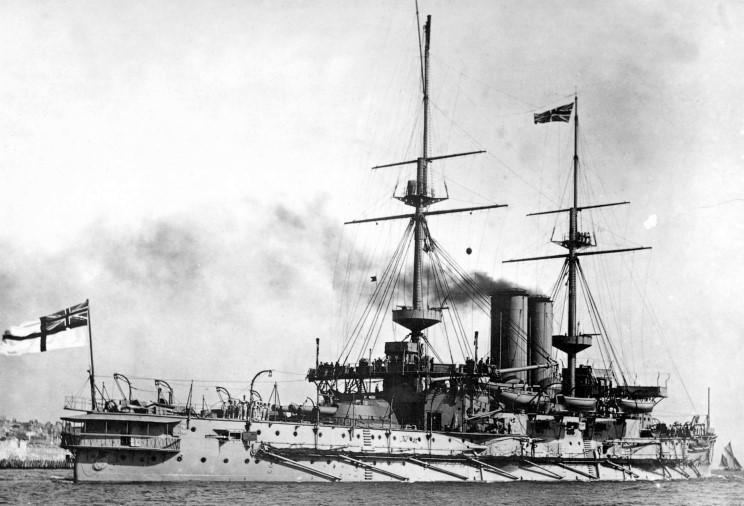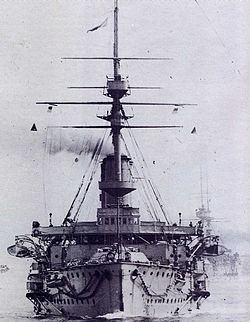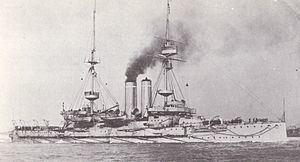Ordered 1896/97 Estimates Laid down 4 January 1897 Construction started 4 January 1897 Length 119 m | Namesake Goliath Cost £920,806 Commissioned 27 March 1900 Launched 23 March 1898 Draft 7.6 m | |
 | ||
Hms goliath 1898
HMS Goliath was one of the six Canopus-class pre-dreadnought battleships built by the Royal Navy in the late 19th century. Commissioned in 1900, she served in the Far East on the China Station until 1905, at which time she joined the Mediterranean Fleet. In 1906, she was attached to the Channel Fleet. Having been mothballed prior to the outbreak of the First World War, she was returned to full commission.
Contents
- Hms goliath 1898
- Technical characteristics
- Pre World War I
- World War I
- Dardanelles campaign
- Loss
- References

Goliath took part in operations against German East Africa, participating in the blockade of the German light cruiser SMS Königsberg in the Rufiji River. From March 1915, she was part of the Dardanelles Campaign, and remained in support of the landings at Gallipoli in April. On 13 May 1915 Goliath was sunk in Morto Bay off Cape Helles by two torpedoes from the Turkish torpedo boat destroyer Muâvenet-i Millîye, which was manned by a combined German and Turkish crew, drowning 570 of her 700 crew members, including her captain, Thomas Lawrie Shelford.

Technical characteristics

HMS Goliath was laid down at Chatham Dockyard on 4 January 1897 and was launched on 23 March 1898. She was commissioned in March 1900.

Goliath and her five sister ships were designed for service in the Far East, where the new rising power Japan was beginning to build a powerful and dangerous navy, so the Goliath class had to be able to transit the Suez Canal. They were designed to be smaller (by about 2,000 long tons (2,000 t)), lighter, and faster than their predecessors, the Majestic-class battleships, although they were slightly longer at 430 ft (130 m). In order to save weight, Goliath carried less armour than the Majestics, although the change from Harvey armour in the Majestics to Krupp armour in Goliath meant that the loss in protection was not as great as it might have been, Krupp armour having greater protective value at a given weight than its Harvey equivalent. Still, Goliath's armour was light enough to make her almost a second-class battleship. Part of her armour scheme included the use of a special 1 in (2.5 cm) armoured deck over the belt to defend against plunging fire by howitzers that France reportedly planned to install on its ships, although this report proved to be false.
Goliath had four 12 in (300 mm)/35 cal guns mounted in twin turrets fore and aft; these guns were mounted in circular barbettes that allowed all-around loading, although at a fixed elevation. She also mounted twelve 6 in (150 mm)/40 cal guns (sponson mounting allowing some of them to fire fore and aft) in addition to smaller guns, and four 18 in (460 mm) submerged torpedo tubes.
Goliath and her sister ships were the first British battleships with water-tube boilers, which generated more power at less expense in weight compared with the cylindrical boilers used in previous ships. The new boilers led to the adoption of fore-and-aft funnels, rather than the side-by-side funnel arrangement used in many previous British battleships. The Canopus-class ships proved to be good steamers, consuming 10 short tons (9.1 t) of coal per hour at full speed, with a high speed for battleships of their time, a full 2 kn (2.3 mph; 3.7 km/h) faster than the Majestics.
Pre-World War I
Goliath commissioned on 27 March 1900 to serve on the China Station, where she underwent a refit at Hong Kong from September 1901 – April 1902. Captain Frank Hannam Henderson was appointed in command 11 July 1902. She left the China Station in July 1903 and returned home, where she paid off into the commissioned Reserve at Chatham Dockyard on 9 October 1903.
While in reserve, Goliath underwent a refit at Palmers on the Tyne from January–June 1904, then participated in maneuvers later in the year.
On 9 May 1905, Goliath returned to full commission at Chatham to relieve her sister ship Ocean on the China Station. However, Great Britain and Japan ratified a treaty of alliance while she was on her outbound voyage, allowing the Royal Navy to reduce its presence on the China Station and recall all battleships from those waters; when Goliath reached Colombo, Ceylon in June 1905, she was recalled, and was instead attached to the Mediterranean Fleet. In January 1906, she was transferred to the Channel Fleet.
After being fitted with fire control, Goliath transferred to the Portsmouth Division of the new Home Fleet on 15 March 1907. She was based at Portsmouth, and underwent a machinery overhaul there from August 1907 – February 1908.
Upon completion of her refit, Goliath commissioned on 4 February 1908 for Mediterranean Fleet service. During her voyage to Malta, one of her propeller shafts fractured, and she required four-month repair period before she could begin her service. On 20 April 1909, she paid off at Portsmouth.
On 22 April, Goliath recommissioned to serve in the 4th Division, Home Fleet, at the Nore. During this service, she was refitted at Chatham in 1910–1911 and was sent to Sheerness. In 1913, she was mothballed and joined the 3rd Fleet, also known as the Pembroke Reserve, at Pembroke Dock in Wales.
World War I
When the First World War broke out in August 1914, Goliath returned to full commission and was assigned to the 8th Battle Squadron, Channel Fleet, operating out of Devonport. She was sent to Loch Ewe as guard ship to defend the Grand Fleet anchorage, and then covered the landing of the Plymouth Marine Battalion at Ostend, Belgium on 25 August 1914.
Goliath transferred to the East Indies Station on 20 September to support cruisers on convoy duty in the Middle East, escorting an Indian convoy to the Persian Gulf and German East Africa until October. She then took part in the blockade of the German light cruiser SMS Königsberg in the Rufiji River until November, during which crew member Commander Henry Peel Ritchie won the Victoria Cross. She bombarded Dar es Salaam on 28 November and 30 November.
Goliath underwent a refit at Simonstown, South Africa, from December 1914 – February 1915. When it was completed, she went back into service as flagship for Vice Admiral King Hall and resumed operations against Königsberg at the Rufiji River until March 1915.
Dardanelles campaign
On 25 March 1915, Goliath was ordered to the Dardanelles to participate in the campaign there. She transferred her flag to second-class cruiser Hyacinth and departed for the Dardanelles on 1 April.
Commanded by Captain Thomas Lawrie Shelford, Goliath was part of the Allied fleet supporting the landing at X and Y beach during the landing at Cape Helles on 25 April, sustaining some damage from the gunfire of Ottoman Turkish forts and shore batteries, and supported Allied troops ashore during the First Battle of Alçıtepe that day. She covered the evacuation on 26 April. She was damaged by Turkish guns again on 2 May.
Loss
Since the Turkish Army had no long range cannons, battleships with large calibre armament like Goliath were able to remain out of range and had caused extensive casualties on the Turkish side. Though it seemed impossible, the Turkish General Staff decided to sink Goliath. On the night of 12–13 May, Goliath was anchored in Morto Bay off Cape Mehmetçik (Cape Helles), along with Cornwallis and a screen of five destroyers, in foggy conditions. Around 01:00 on 13 May, the Turkish torpedo boat destroyer Muâvenet-i Millîye eluded the destroyers Beagle and Bulldog and three others and closed on the battleships. The Muâvenet-i Millîye reversed down the Dardanelles, moved slowly, stern first, and was mistaken by officers on watch for a British vessel. It fired two torpedoes which struck Goliath almost simultaneously abreast her fore turret and abeam the fore funnel, causing a massive explosion. Goliath began to capsize almost immediately, and was lying on her beam ends when a third torpedo struck near her after turret. She then rolled over completely and began to sink by the bows, taking 570 of the 700-strong crew to the bottom, including her commanding officer, Captain Thomas Lawrie Shelford.
Although sighted and fired on after the first torpedo hit, Muâvenet-i Millîye escaped unscathed. Goliath was the fourth Allied pre-dreadnought battleship to be sunk in the Dardanelles; after her loss the flagship Queen Elizabeth was sent back to England. For sinking Goliath, Turkish Captain of Muâvenet-i Millîye Ahmet Saffet Bey was promoted to rank of Commander (Major) and awarded the Gold Medal and the German consultant, Kapitänleutnant Rudolph Firle was also awarded the Gold Medal by Ottoman Sultan (Rudolph Firle was also awarded the Iron Cross 1st Class by the German General Staff because he was a German national).
